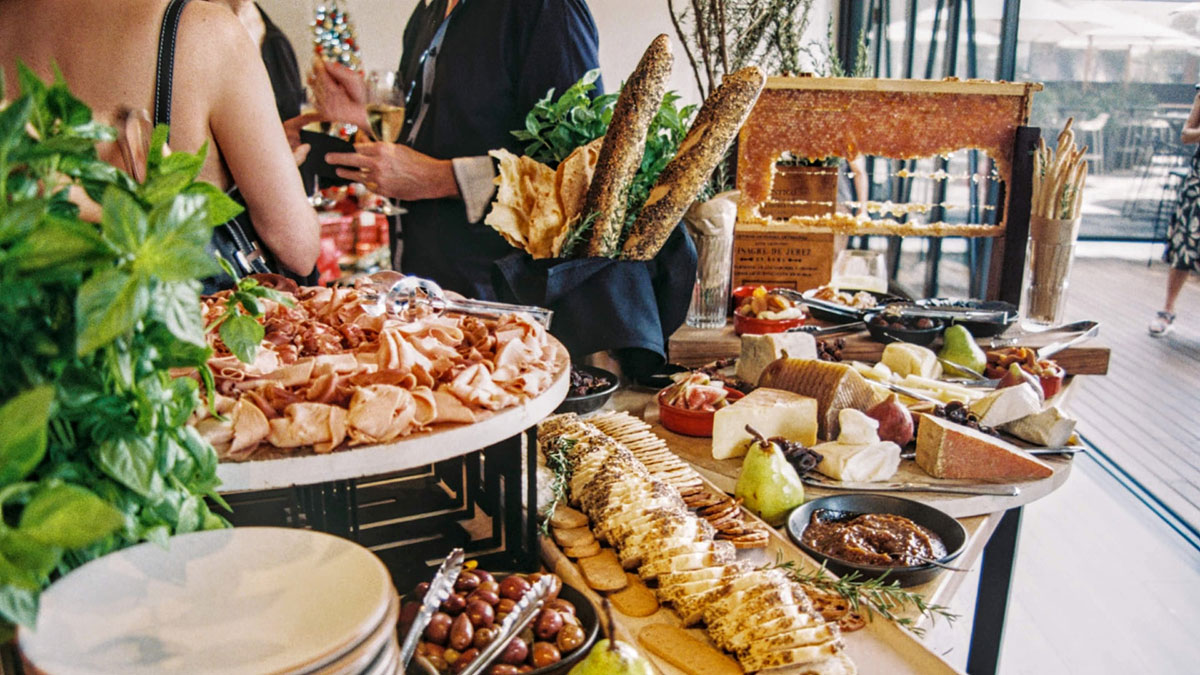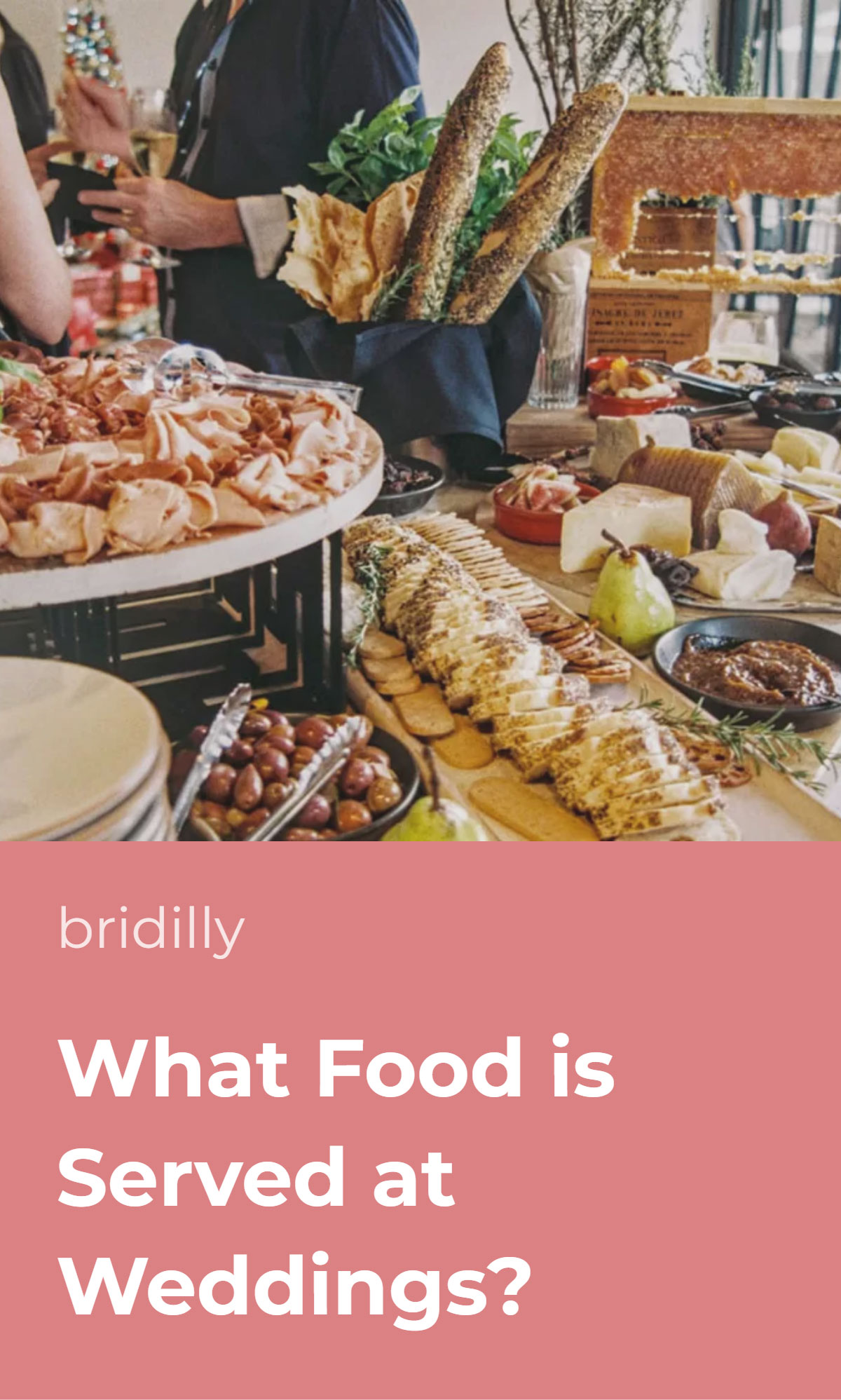The wide variety of wedding food types is mind-boggling. The choice of a reception menu is, perhaps, one of the most challenging in the entire wedding planning process.
Nothing wrong with feeling disoriented when reading through hundreds of wedding dinner ideas. To decide which meals are the right fit for your event, you must first choose your dinner type. Will you go for a formal plated dinner or a laid-back cocktail-style wedding reception?
Once you’ve chosen the reception type, your next step must be defining your wedding theme. Like any other element, food is a part of visual appeal and must be appropriate.
A typical wedding catering package consists of finger foods, the main course, and a dessert.
Traditionally, a wedding cake is in the spotlight, but some couples nowadays waive it and opt for dessert stations instead. Either way, all dinner elements must be tied with the same style.
After you consider the main points, choosing the right dishes becomes much more manageable.
Most importantly, follow your own culinary preferences but don’t forget about your guests. It would be best if you accommodated the taste and health conditions of all dinner attendees.
Table of Contents [show]
Plated Dinner vs Buffet vs Other
The first step in creating your wedding menu is deciding on the reception type.
Plated and buffet-style receptions are the most common among couples in the US, but food stations, family-style dinners, and cocktail receptions are also available.
A plated dinner is a formal reception type where the guests are seated and served courses from a limited menu. At a formal dinner, guests shouldn’t handle food themselves.
The main course of a plated dinner can be chosen in three ways. The guests may be served a meal of their choice from a menu, can choose the desired meal when submitting RSVP, or may not have a choice at all.
A plated wedding reception lets you create an exquisite atmosphere and have total control over the menu. It’s also the most efficient reception option in terms of required serving calculation.
However, a plated dinner is typically more expensive than a buffet because it involves waiters’ labor. A limited variety of meal options may also become an issue.
A buffet-style wedding reception features tables offering a range of meals that guests must serve themselves. It’s a great way to appeal to everyone’s taste. Plus, buffets are usually cheaper than plated dinners.
Buffets have drawbacks, too. The lines to a buffet table tend to be long, and some people consider buffets not formal enough for such an event.
In addition, the required serving estimation is a real challenge, and most couples order too much food that must be disposed of afterward.
A family-style dinner is a less common form of a wedding reception. As the name suggests, it’s not much different from your regular family meal. Plates are passed around the table, and guests serve the food themselves.
This style has a laid-back vibe and is best suitable for small weddings.
Food stations are similar to buffets in the sense that guests handle serving on their own. But unlike buffets, food stations are dedicated to a specific food type.
So, instead of mixing cheese, fish, ad desserts on the same table, you would have three different tables.
Finally, a cocktail-style wedding reception is the least formal type yet certainly not the least fun. It doesn’t involve seating charts and meal serving.
Instead, guests can mix as they wish and only eat finger foods, typically passed on trays. This reception style requires great attention to food options and beverages not to look tacky.
A menu is a part of the overall wedding style. It should be appropriate for the chosen venue, guest count, and even formality.
Let’s assume you want a formal plated dinner without a particular theme, but elegant and sophisticated.
Of course, you can follow your personal preferences, and no one obliges you to serve specific foods. But country-style meals such as casserole or stuffing may look odd at such a reception.
On the flip side, if you host a cowboy-themed wedding, no one expects you to serve oysters. If you host a themed wedding, the menu must follow the same theme, too.
As a rule of thumb, don’t mix foods from different cuisines at one dinner. Of course, there may be exceptions, like a travel-themed wedding where you intentionally serve foods from all over the globe. But in most cases, this will create dissonance.
Your wedding menu should also fit the season. For example, heavy foods are best for winter events, while spring requires something fresh and light.
Wedding Finger Food
Wedding finger food can serve as a starter or as a main course depending on the reception type. Such appetizers are always small and can be eaten with hands rather than utensils unless it’s a plated reception.
Finger foods ensure guests don’t get bored and overly hungry while waiting for the main meal.
When choosing finger foods for your wedding, consider the taste preferences and allergies of your guests.
It’s best to serve a wide variety of options to accommodate everyone’s needs and wants. Also, don’t forget to include vegetarian and gluten-free options.
Some of the most popular wedding appetizers include mini quiches, seafood, sliders, skewers, spring rolls, stuffed mushrooms, and meatballs.
This list should only give you an idea of what to serve, but any appetizer should follow the overall menu style. Appetizers can be cheap and DIY-friendly, like crackers with cheese, or luxurious, like sliders with black caviar.
Main Courses
The variety of main courses is always narrower than finger foods, regardless of the reception type. However, the same rules as for appetizers apply.
You can easily offer multiple options with a buffet-style reception, including fish, meat, and vegetarian.
But couples choosing a seated dinner sometimes neglect the preferences and allergies of guests. The fact that you prefer fish doesn’t mean that others like it, too.
Finding out what your guests desire in advance is crucial. That’s why a menu is beneficial at a plated dinner.
“Fish, steak, or chicken?” isn’t the only question to ask yourself when choosing the main courses for your wedding. The selected recipes must fit the atmosphere and style of the dinner.
You can roast poultry for a rustic-style event or make spicy Kadai chicken for an oriental-themed dinner.
Fish and chips are an excellent fit for an informal buffet-style dinner, while scallops and oysters suit glamorous plated receptions. The vibe of the meal is determined not by the ingredients but by the way they are cooked.
Desserts
Some couples only have a cake at their wedding. However, your guests may not like the chosen cake flavor or not eat cakes at all.
A separate dessert station helps to please everyone. Some wedding dessert ideas are even more exciting than a traditional cake.
Ice cream is a go-to for summer events. Homemade pies or cinnamon rolls are a modern choice for country-style or rustic weddings.
Croquembouche tower or macarons are sophisticated French desserts appropriate for the most formal receptions. Cake pops and cotton candy are a fun and colorful alternative to cupcakes.
You may even waive the wedding cake entirely and focus solely on sweet finger foods. In this case, make sure you offer a variety of options. Sweet stations are a contemporary choice and look incredible in pictures.
Wedding Cake
Traditionally, the wedding cake is even more important than the main course. It symbolizes happiness and the beginning of good new life for the couple.
Today, wedding cakes are viewed merely as beautiful centerpieces, but cake-cutting remains one of the most important event moments.
Couples tend to put immense effort into choosing the perfect cake flavor and design, and it’s no wonder. No other meal is photographed as much as the cake. It’s the real showstopper.
When deciding on your wedding cake flavor, think of whether you want a traditional or unique option. The cake choice should express your and the groom’s personalities and fit the event theme.
Some of the most popular wedding cake flavors are buttercream, red velvet, chocolate, lemon, and pink champagne. However, you can stand out by choosing green tea ganache, lavender and mocha, or other rare flavor combinations.
It would be best to consider the wedding color scheme and its suitability for the chosen taste when it comes to decoration.
Discuss your desired design with the baker before ordering to ensure it can be recreated with a specific flavor. For instance, some cakes may be too soft for a heavy gum paste decoration.
Beverages
Some couples neglect beverages while focusing on the food menu. However, beverages play an essential role in creating the atmosphere and keeping your guests entertained. They also make up nearly half of the catering price.
It would be best if you offer both alcoholic and non-alcoholic drinks at the reception. Furthermore, you can’t serve one type of each, like champagne and juice. Same as with food, your guests have different drink preferences.
Wine, champagne, and beer are the safest, easiest, and cheapest alcoholic beverage options. They are suitable for nearly any dinner style. However, when choosing wine, ensure it fits your menu.
Cocktail-style receptions are an exception. However, as the focus of such dinner shifts from food to beverages, you should consider offering professionally made cocktails.













No Comments Add one
Leave a Comment